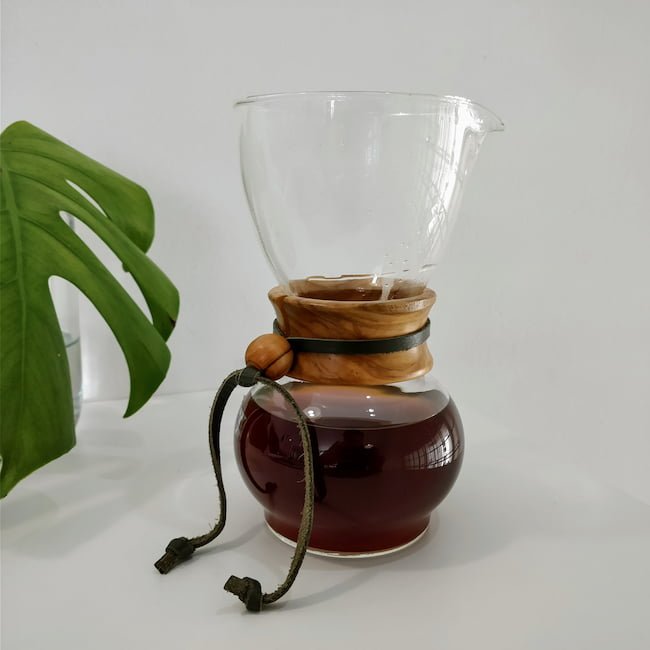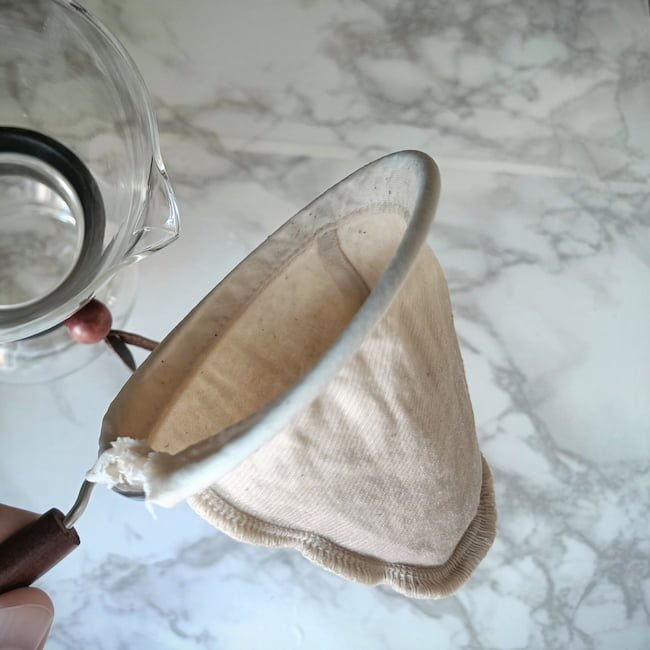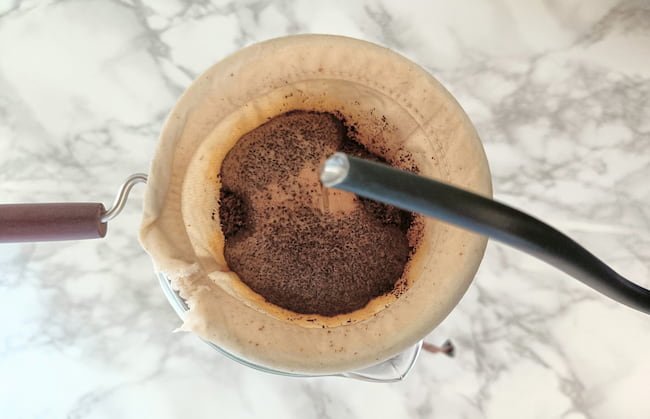It wasn’t until several years after my first rendezvous with nel drip coffee that I realized just how amazing it is.
Back in the days when I first got into specialty coffee, I happened to visit a coffee shop that used this method.
The cup I had at that place was mind-blowingly epic. I kept fantasizing about it for months.
Being only a burgeoning coffee snob, I didn’t pay much attention to the brewing method. Instead, I focused on the roaster and the bean varietal, which I would both put on a pedestal.
It wasn’t until several years later that I realized that the main reason the coffee was so memorable was not due to the beans – it was instead due to the brewing method.
So if you see somebody brewing coffee with something looking like an old, dirty sock, do not underestimate them! 🙅
If you're a coffee snob, it belongs in your collection
What is Nel Drip Coffee?
Nel drip coffee makers rely on flannel filters instead of paper filters. That’s the main difference.
It quickly gets tiresome to say “flannel,” so for that reason, people tend to call it “Nel Coffee” today, just skipping the first part of the word.
The Japanese are often credited with the invention of nel drip coffee. However, it seems that many countries worldwide have had their version.
For instance, if you’re in Brazil and order a cafezinho on the side of the road, then it will most likely be brewed with a cloth filter.

Even in my birth country of Denmark, cloth filters used to be quite common back in my grandparents’ day. They were used with the widespread percolation device known as “Madame Blå,” which resembles the logo of this website (except just being pastel blue instead of ochre).
So cloth filters aren’t unique to Japan. But somehow, the country and its coffee culture are intertwined with the modern renaissance of pour over coffee.
In the following sections, we’ll look at why that is.
What Makes Nel Drip so Different?
In coffee, we’re broadly speaking used three types of filtration today.
- Paper filters are super common and could almost be considered the standard. The result is a very clean cup with no sediment and only tiny amounts of coffee oil.
- French press is the polar opposite. It’s dirty and muddy, and you tend to get some sediment in your cup.
- Espresso is filtered with tiny metal holes in the basket. The cup will be relatively clean compared to the French press, but on the other hand, you’ll have crema, which impacts the perception of the cup.
Nel drip or cloth filters share common traits with paper filters. However, they tend to let more coffee oils pass through the filter and into the cup.
The result is a cup that is both different and familiar.
It’s more round, bolder, sweeter, more intense than a paper-filtered cup.
Paper filters tend to highlight acidity and clarity a bit more, but one can say that nel filters do a better job on most other parameters.
So how come nel filters are not more widespread when the coffee is so tasty?
Well, I think there are several reasons for it. But the main reason is probably that in comparison paper filters and metal require minimal upkeep

The ultimate nel dripper? Hario Woodneck Review
So now we know a bit about the nel dripper and its history. You’re convinced that you need to try this type of coffee. The big question then is, what nel dripper should you invest in?
Well, the good news here is that the market for nel drippers is pretty tiny and not something you have to spend weeks perusing.
Let me suggest the Hario Woodneck, the most popular gadget among the cloth drippers.
The Hario Woodneck looks a little bit like the goofy cousin of a Chemex. However, it’s a quirky device with some charm.
It’s constructed in a way, so the cloth filter can rest on top of the brewer and has plenty of room to expand. Then, after you’re done brewing, you remove the cloth filter and use the carafe to serve the coffee.
There are several reasons to go for the Hario Woodneck:
- It’s beautiful and stylish
- It’s easy to find cloth filters that fit the filter holder since it’s the most common nel dripper
- It’s relatively affordable
However, if you don’t feel like investing in a new device, you can also get the filter holder and a cloth filter, and do like some Japanese coffee masters do: hold the filter in the hand while brewing. Of course, it will require a steady hand and some patience, but this is also an option.
How Do You Brew Nel Drip Coffee?
There are many different approaches to brewing nel drip coffee.
One common way is a Japanese style that has been popularized by James Freeman, the founder of Blue Bottle Coffee.
In his book about coffee, he explains that he tried this coffee for the first time at the legendary Café l’Ambre in Tokyo.
“The coffee was so diligently prepared that I was perplexed at the ratio of showmanship per milliliters of coffee. But once I tried it, I was baffled and then furious that I never had coffee this stunning and complex—with such a bewildering viscosity—in my whole life,” he recounts.
According to Freeman, the perfect Japanese way to brew a nel drip is this way:
- 50 g coffee. Very coarse grounds
- 280 g water at 175°F / 79°C
- Add the coffee to the filter. Slowly groom the outside of the coffee bed with a butter knife or slim spatula. Make a slight indentation in the middle of the brew bed.
- Pour 50 g of water carefully for the bloom.
- At 45 seconds, begin the second pour up to 160 g total volume. Slowly spiral your way out to the edges.
- Pause for 30 seconds
- Pour again, bringing the water up to 280 grams using the same pattern and timing.
My opinion:
This recipe will give you a potent yet underextracted coffee since it’s brewed at an intense 1:5.6 ratio. This ratio is not far from espresso strength.
However, due to the coarse grounds, low temperature, and agitation, the coffee will also be quite underextracted, which of course, means a smaller amount of dissolved solids than what you might expect from that ratio.
If you’re used to specialty coffee, you might find the flavor of this brew a bit puzzling. But my feeling is that most regular coffee drinkers will find this cup profile very delicious.
If you’re going to try this at home, I’d suggest using a medium to dark roast, which incidentally is also more in line with the Japanese coffee style.
Osmotic flow style Nel Drip
My favorite way to brew nel drip coffee is a lot more in line with typical specialty coffee compared to Blue Bottle’s approach. However, I like to experiment with some of their ideas, for example, using more developed roasts, lower water temperatures, and slightly more narrow ratios.
Still, I typically stay in the range of 1:14-1:15.
Other than that, I pretty much follow the same pouring pattern that I outline in my video about the Osmotic Flow technique.
- Use a 1:15 ratio
- Bloom with 2-3 times coffee weight. Wait 45 seconds
- Pour slowly in the center until 50% of the total water weight has been reached.
- Then slowly work your way towards the edges with spiral pours.
- Total brew time should be 3-4 minutes.
This coffee should taste like a typical pour over but with more body and subtle acidity.
How do you clean a nel drip filter?
Cleaning the filter is the most tedious and tricky aspect of this type of coffee.
There are several things you want to avoid:
- Don’t let the filter dry out! This will make the filter more fragile, and off-flavors tend to appear if this happens
- Don’t let the filter sit for ages with old grounds stuck
- Watch out for any mold or mildew starting to grow
Here’s a quick guide on cleaning and storing the filter the proper way.
Before the first use
Boil the filter with plenty of water in a pot for 5-10 minutes. Then rinse it a few times with cold water. This will get rid of any nasty off-flavors.
Daily cleaning
After each use, you should clean out the coffee grounds and give the filter a good rinse under the sink. Then, turn it inside and out, and use your hands.
Do this not too long after brewing your coffee. You don’t want the filter to dry out.
Then take the filter off the wire, and fold it into a small ball. Next, put it in a little jar. With or without a lid doesn’t matter as long as the filter is fully submerged. Then place the jar in the fridge until the filter is used next time.
When you’re going to brew next time, take the filter out of the fridge and glass, give it a quick rinse under the tap, and then preheat the filter with almost boiling brew water.
Long term storage
If you’re not going to brew with the cloth filter for a while, then you can store it in the freezer. Just squeeze out excess water, fold up the filter once or twice, and put it inside a ziplock bag. Now the cloth filter will be safe.
Deep cleaning
If the filter starts to look nasty, then soak it with a teaspoon of Cafiza in a cup. Even though this powder is created for espresso machine cleaning, it also works well for this purpose. Cafiza will help you get rid of any coffee oils. Rinse the filter thoroughly in running water to get rid of any residue.
Conclusion
Cloth filter, aka nel drip coffee, is super underrated. From specialty coffee geeks to mainstream caffeine “normies,” I could see anybody enjoy this brewing method. The only downside is the cleaning, which is more involved than regular drip coffee.
But if you’re the kind of person who’s a bit OCD about your coffee ritual, then I think you’ll be able to manage it.
I’m pretty forgetful about most chores, but I seem to be pretty good at staying on top of my nel routine for some reason. I have had my current cloth filter for almost a year now, and it still looks great and doesn’t have any bad smells. So don’t be scared away, and give it a try!
➡️ See more reviews
FAQ
Nel drip coffee is a type of coffee that is brewed with a cloth or flannel filter. Most often, it’s prepared using the pour over method.
You can use a wide range of techniques. Some people steep the coffee and use the cloth for filtration. However, the most common way is to use the pour over method. You use a gooseneck kettle and slowly drip the water onto the grounds.
Since cloth lets more oils from the coffee than paper filters, the coffee has an entirely different character that can be hard to describe accurately. It’s like a mix of the best attributes from the French press and pour over combined into one brewing method. It’s truly unique.


